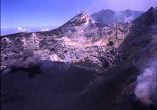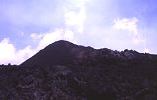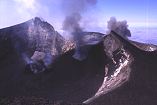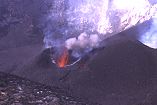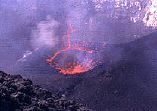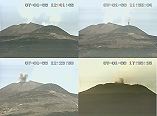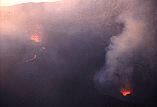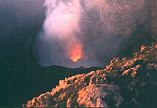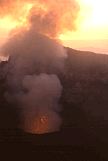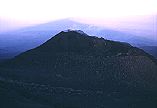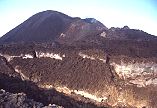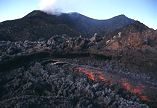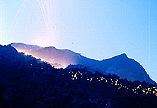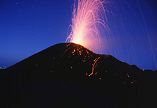Etna Current Activity [ Etna Home Page | Italian volcanoes map | Main Index | Home Page ]
Etna Decade Volcano, Sicily, Italy
Updates 1-15 July 1998
The most recent updates
Etna news archive
15 July 1998
Jürg Alean visited Etna's summit again yesterday (between the afternoon an 02:00 h last night) and reported the following: After a period of virtually no activity both vents within the Voragine showed intense activity, at times being more vigorous than that observed two days ago. The southwestern vent was filled almost to the rim by fluid lava which was fountaining vigorously; different from two days ago, no ash was produced by this activity. The central vent displayed a similar eruptive behavior as on the previous visit, but this time no lava bubbles were observed. The explosions were somewhat stronger than two days ago, but most jets were directed towards the east. This activity lasted a few hours and was followed by another hours-long period of quiet and yet another period of eruptive activity.
Observations of the activity within NE Cratercould not be made. The activity at Bocca Nuova was also slightly stronger than on 13 July, the principal eruptive activity occurring at the northern cone. This cone produced dense fountains heavily charged with bombs, many of which fell onto the crater rims (mainly on the western and northern sides) and into neighboring Voragine. Jürg Alean did not approach to the crater rim due to this activity, and no information about the activity at the southeastern vents is available. SE Crater continued to produce continous Strombolian activity, ejecting many bombs beyond the former crater rims and thus making any approach to the active effusive vents impossible. From the Torre del Filosofo mountain hut a small lava flow could be seen descending on the upper southeastern flank of the SE Cone: incandescent blocks frequently detached from the flow front and avalanched down the flank.
13 July 1998
The following describes activity observed at all four summit craters this morning; this activity is very intense and spectacular, but nonetheless it is "only" the continuation of a three-year-long summit eruption, and not a significant change in the eruptive behavior of the volcano. The summit visit was made by Giovanni Sturiale, Sandro Privitera and Boris Behncke, all of the Istituto di Geologia e Geofisica of Catania University, and Jürg Alean who most of you know as one of the makers of Stromboli On-line.
The most vigorous activity occurred at both vents of the Voragine. Yesterday, continuous lava fountains had roared up to 200 m above the crater rim for three hours (ending on about 19:30 h local time) from the southwestern vent, followed by relative quiet in the crater. This morning at about 09:00 h, when we reached the "parking place" on the western side of the saddle between NE Crater and the main summit cone, powerful jets of bombs mixed with ash were ejected from the southwestern vent; many bombs fell outside the crater in the area to the north of Bocca Nuova, and near the low northwestern rim of Voragine which until some time ago was the best observation point at that crater. Upon reaching the southern rim of NE Crater, the cone around the southwestern vent was found much larger and higher than during the previous visit by Behncke on 4 July: the top of the cone was higher in places than the "diaframma" (the wall between Voragine and Bocca Nuova); the vent was some 30-50 m across. During 90 minutes of observation, activity at this vent was near continuous but varied from isolated powerful explosions to long-lasting lava fountains; the earlier usually contained various amounts of ash and often ejected large (several meters in diameter) bombs up to 100 m beyond the crater rim, mostly in the direction of Bocca Nuova. At times dense ash plumes mixed with large incandescent bombs rose from the vent. During observations from the southern rim of Bocca Nuova between 1315 and 1345, episodes of continuous fire-fountaining occurred from the same vent, each such episode lasting some 5 minutes.
The central cone in the Voragine was the site of tremendous explosions which blasted huge lumps and blobs of lava all over the crater area and outside the crater in all directions. There were at least two sources of explosions in the main vent of the cone, and more rarely, smaller lava fountains and ash emissions occurred from two fissures, one extending from the southwestern wall of the main vent towards the large southwestern cone, the other being a concentric fracture on the western side of the main vent. The main vent was about 30-40 m across; the cone around it was significantly higher than during the 4 July visit, but still lower than the low northwestern crater rim. Explosions from the two sources in the main vent at times alternated and at other times occurred simultaneously. The southwestern of these sources produced more ash and slightly less noisy explosions while the northeastern source produced ash-free blasts accompanied by terrific cannon-shot like detonations and pressure waves. Between explosions, the surface of the magma column was exposed on the vent floor, at times smaller explosions ruptured this surface. On at least 20 occasions during 90 minutes observation from NE Crater's south rim, the magma surface in the vent was seen to dome up, forming a huge bubble that exploded with a powerful blast after a few seconds. Five of these blasts were followed within about 15-30 seconds by the growth and explosion of a second bubble; many blasts, however, occurred without preceding updoming of the magma.
Much more powerful explosions occurred after we left the vantage point at NE Crater and reached Bocca Nuova from SE Crater, about 90 minutes later. These explosions ejected abundant meter-sized bombs 200 m or higher above the vent; many of these bombs fell into the Bocca Nuova (as far as the southern part of the crater floor) while others fell outside the Voragine to the west, east, and southeast. Some bombs were seen to fall even on the eastern slope of the main summit cone, not very far from the SE Crater. Air concussions and ground tremor accompanied this activity.
Mild Strombolian activity was occurring from deep within the central pit of NE Crater, ejecting bombs above the rim of the pit; some bombs found on the cluster of small cones formed in the summer of 1996 on the SW rim of NE Crater appeared to be products of this activity. This indicates that the activity of NE Crater may threaten people who choose its southern rim as an observation point for the Voragine.
At SE Crater, Strombolian activity was vigorous but similar to that seen on other occasions during the past 12 months. Bombs fell frequently outside the crater to the west. Lava emission was continuing from the effusive vent area on the southern flank of the central conelet, feeding a small flow on the upper southeastern flank of the SE cone. Recent lava had filled the southwestern part of the crater floor to within only 1-2 m of the western crater rim. In all other areas the pre-1997 rim of SE Crater has been buried by overflowing lava, and the shape of the crater has changed notably during the past 12 months.
Observations of the Bocca Nuova were made from its southern rim after stating that only very few bombs had fallen here during the past few days. The southeastern vents showed low levels of activity; the main vent produced a dense gas column that was at times expelled with some violence and rarely contained bombs. A small cone had grown within the collapse crater around the main vent. The northern eruptive area was the site of Strombolian bursts that occurred at intervals of 5-10 minutes, in a manner strikingly similar to eruptive bursts usually observed at Stromboli volcano. A single vent produced eruptions; only during the largest of these events did bombs fall onto the western and northern rims of Bocca Nuova. A fairly large cone had grown at this vent, the first time that significant cone growth has occurred in Bocca Nuova since late 1997. Lava had recently extended over the southern crater floor but its source had been buried by the growing cone.
For a description (in Italian!) of a visit to Etna's summit craters on this weekend by journalists of the newspaper "La Sicilia" (published today, 13 July 1998) click here.
7 July 1998
Reports from visitors to Etna's summit in the past few days and Stefano Branca (Istituto di Geologia e Geofisica of Catania University) indicate high levels of activity. Members of the Association Volcanologique Européenne (L.A.V.E.) of Paris observed very intense activity on the evening of 7 July at the southwestern vent of the Voragine that dropped bombs as far as the southern rim of NE Crater. That same evening they visited the active lava flow on the southwestern flank of SE Crater which was advancing downslope, having attained a lenth of about 200 m. Flow movement had slowed the next morning. No specific observations were made of Bocca Nuova. Stefano Branca reported that frequent explosion noises were audible throughout yesterday (6 July) at Viagrande, a village situated at the southeastern flank of Etna. The explosions most probably originated at the southwestern vent of the Voragine which has been the site of the most noisy activity in recent weeks. At Viagrande, air concussions associated with the explosions shook windows and rattled doors; loud bangs were heard every 30 seconds or so around noon. No reports about particular visible activity were available. Today, explosion noises were still audible but they were much less intense than yesterday. Branca is intending to visit the summit area tomorrow.
6 July 1998
No significant changes in the activity of Etna have occurred over the weekend. The activity is confined to the four summit craters, and the only lava outflow is occurring at SE Crater while lava effusion has been observed within the deep pit of Bocca Nuova and neighboring Voragine on various occasions in the past month. Deep-seated Strombolian activity within the central pit of NE Crater is said to have resumed in mid-May (information from Vittorio Scribano, Istituto di Scienze della Terra of Catania University).
News reports outside Italy have evidently created the impression of something quite unusual going on on Etna last week; spectacular footage of lava fountaining within the Voragine circled the globe in the television news (see a 2 July 1998 report on the BBC web site). However, the volcano remains in stable conditions. Activity at the summit craters is continuing since almost 3 years and has been characterized by a wide variety of eruptive phenomena and vent locations. The fact that no eruptive activity has occurred on Etna's flanks since more than 5 years indicates that the volcano is structurally more stable than it had been for the previous 22 years (1971-1993).
5 July 1998
During a summit visit by Boris Behncke (Istituto di Geologia e Geofisica of Catania University) and members of the Association Volcanologique Européenne (L.A.V.E.) of Paris on 4 July, all four summit craters were found in activity. For the first time since 28 March, eruptive activity was observed directly at NE Crater, site of an episode of vigorous lava fountaining during the night of 27-28 March. The site of this activity was a 30-m-diameter vent in the northwestern part of the central pit while another vent (about 15-20 m in diameter) in its southwestern part emitted only dense vapor plumes. Small Strombolian bursts from the larger vent occurred every 2-5 minutes, with most ejecta falling back into the pit, but occasionally bombs fell outside the pit on the northwestern crater floor; a few scattered bombs were found in the northern part of the crater floor on the outer terrace formed after the cessation of the major 1995-1996 eruptions. Night glow at NE Crater had been first observed on the evening of 22 June by IIV scientists working at the Observatory at Pizzi Deneri, some 3 km northeast of NE Crater.
At SE Crater, explosive activity was significantly more intense than during previous visits, with bombs falling frequently outside the crater, and making any approach to the effusive vent area on the southern side of the intracrater cone impossible. Activity occurred from one single vent on the top of the intracrater cone which had not grown much since last observed by Boris Behncke on 22 June; jets of bombs and scoriae rose up to 150 m above the vent, and bombs mainly fell towards the south and southwest. Lava issued from at least two vents on the southern side of the intracrater cone, one feeding a very slowly moving flow that spilled over the southwestern crater rim and descended about 150 m downslope adjacent to a much larger flow emplaced in late March. The footpath had not yet been buried by the new lava. Another lava flow was issuing from a vent on the western side of the area of effusive activity, and advancing slowly northwestwards on the western side of the intracrater cone.
A scoria deposit extending to the southeast was produced by the lava fountaining episode of 1 July of the Voragine. This deposit was examined while visiting SE Crater which lies in the main axis of fallout. On the western rim of SE Crater, the deposit is near continuous; clasts range in diameter from 1-2 cm to 15 cm. The scoriae are highly inflated, similar to the distal portion of the 27-28 March pyroclastic deposit of NE Crater. To the northwest of SE Crater (on the eastern flank of Etna's main summit cone), the deposit consists of isolated scoriaceous clasts up to 20 m in max diameter; still farther north there are isolated dense bombs that increase in diameter (up to 50 cm) towards the northeastern rim of the Voragine. These bombs are probably not related to the fountaining episode, but have been rather ejected during the more "normal" activity occurring in the Voragine.
On 4 July, both vents in the Voragine were in vigorous, alternating activity. Eruptive cycles at the southwestern vent produced continuous jets of highly fragmented pyroclastics directed northwestwards, accompanied by deafening roaring sounds. As activity waned at this vent, projections of large incandescent bombs would initiate at the central vent, increasing progressively in frequency and height to develop into a continuous though pulsating fountain. Activity at the central vent was much less noisy, but fountains rose at least 100 m above the crater floor, and at times more than 100 m above the highest point on the crater rim (the 1964 cone remainder on the southern crater rim), and some bombs fell outside the crater on the eastern side. Many jets were directed obliquely in different directions, making this activity quite hazardous to observers standing on the northeastern and northwestern crater rims which are lowest and therefore closest to the erupting vent. The activity at this vent continued for at least two hours before continuous fountaining was replaced by discrete explosions and then the complete cessation of activity. Only a few minutes later, powerful bomb ejections accompanied by the emission of dense brownish ash clouds would mark the beginning of another eruptive cycle at the southwestern vent.
The filling of the Voragine had proceeded rapidly during the past few weeks, with major growth occurring at the southwestern vent; this pyroclastic edifice had grown as high as the "diaframma". Circumferential cracks around the active vent indicated some subsidence at this pyroclastic edifice, possibly due to compaction of the very rapidly emplaced deposits. Cone growth at the central vent was less conspicuous, and the lava field surrounding this cone had actually subsided by some 10 m, leaving a ledge on the eastern-northeastern inner crater walls that marked the level of the highstand of the lava fill. The maximum depth of the Voragine (relative to the northwestern crater rim) was only about 30 m (but note that distances and depths can only be estimated with extreme difficulty, and this value may be little accurate), while one year ago, the crater was some 80-100 m deep.
No direct observations were made of the Bocca Nuova due to very violent explosive activity and a strong gale that raged over Etna's summit area that blew to the west. The main source of activity appears to have been the northern eruptive area that produced high fountains heavily charged with huge chunks of incandescent lava every 3-5 minutes; at times there were series of fountains in rapid succession. The highest jets rose more than 150 m above the western crater rim; due to the strong wind most ejecta fall back into the crater, but the presence of very fresh, meter-sized bombs flattened upon impact up to 150 m northwest and west of the crater rim indicated that similar activity during the preceding days when there was no wind had much more widespread effects. One at least one occasion, bombs were seen falling onto the upper southwestern flank of Etna's main summit cone; in this case the source vent may have been in the southeastern eruptive area.
Although the intensity of the activity was lower during the 4 July visit than it had been a few days earlier, the overall levels of activity are the highest observed on Etna in many months. Simultaneous activity at all four summit craters had been last observed from August to October 1997, during a similar period of heightened activity. However, the volcano is in a reasonably stable condition. Eruptive activity is confined to the summit craters and may continue in a similar manner for many months or even years to come. Provided the activity continues at these levels, the Voragine will be eventually filled by the productes of the erupting vents; a similar process in the Bocca Nuova is assumed to take much more time. The infilling of SE Crater is nearing completion with lava again flowing in the western part of the crater while vertical growth of the intracrater cone has slowed, the major growth now being rather lateral.
2 July 1998
Activity from three of Etna's four summit craters continues at heightened levels. Last night, another episode of more vigorous lava fountaining occurred at the Voragine. Frequent ash-rich explosions occurred yesterday and last night at Bocca Nuova; ash plumes rose a few hundred meters above the summit at dusk yesterday. The source of these explosions was at the northern eruptive area. SE Crater had intermittent Strombolian explosions from the central intracrater cone while lava was spilling in surges down the west-southwestern flank, close to the climbing route that has been used by many visitors in recent months. The lava does not appear to have formed a long consistent flow but surges rather produced small overlapping lobes of lava, in a manner similar to that observed on the evening of 22 June.
Seismic activity increased during the fountaining episode of early 1 July, with 11 earthquakes registered by the Geophysical Observatory of Acireale. None of these were felt by the population, and there are no indicators of imminent flank eruption. The activity, though spectacular, is within its normal range, with occasional flurries and periods of low-level activity. Eruptive activity at Etna's summit craters began nearly three years ago (late July 1995) and has continued in a highly variable manner since then, involving all four craters (at times simultaneously). There has been no period of similarly continuous and intense summit activity since about 30 years, and this may indicate that presently the volcano is prone to summit activity rather than to flank eruptions.
1 July 1998
Shortly after midnight last night, an episode of more vigorous lava fountaning occurred from the Voragine. From the preliminary information available at this time (early afternoon of 1 July), the episode was short-lived (it lasted between 30 minutes and one hour) and involved both vents that have recently been active on the floor of that crater. Bombs fell abundantly on the eastern side of Etna's main summit cone. Today, occasional ash-rich explosions occur from the northern vent area in Bocca Nuova while slow lava effusion is occurring from SE Crater, accompanied by mild Strombolian activity. Some of the explosions at the intracrater cone of this crater produce small ash plumes.
Visits to the summit area in the past few days by geologists of the Istituto di Geologia e Geofisica of Catania University (Stefano Branca: Friday 26 June, Carmelo Monaco: Sunday 28 June and Giovanni Sturiale: Monday 29 June) and of the Istituto Internazionale di Vulcanologia revealed that the activity at SE Crater is relatively modest, with long periods of quiet between periods of Strombolian activity. On the other hand, lava effusion is continuous. The effusive vent is located on the southern side of the central intracrater cone, and flows are now spilling downslope in the sector bounded by the WSW and NE flanks of the SE Cone.
Activity within Bocca Nuova was observed directly only for a very brief period by Sturiale before a powerful vertically directed explosion sent scores of bombs high above the crater rim; the source of this explosion was at the northern eruptive area where two small cones had formed around the active vents. Minor activity was occurring from the southeastern eruptive vents in Bocca Nuova. Observations by Monaco and Branca reveal that explosions from the northern vents in that crater occurred infrequently during their visits but were very powerful, and at least on one occasion ejected large quantities of ash.
The Voragine displayed significant fluctuations in its eruptive behavior. On 26 June, both its central and southwestern vents were erupting, and two days later, Hawaiian-style lava fountaining occurred at the central vent while the southwestern vent emitted mainly ash. On 29 June the central vent was quiet but the southwestern vent was the site of episodic lava fountaining. Sturiale reports that both the central cone and the pyroclastic edifice at the southwestern vent had grown significantly since the 15 June visit, with scoriae piling up to the crest of the "diaframma", the thin wall between Voragine and Bocca Nuova.
Page set up on 6 June 1998, last modified on 17 August 1998
Hosted by VolcanoDiscovery
